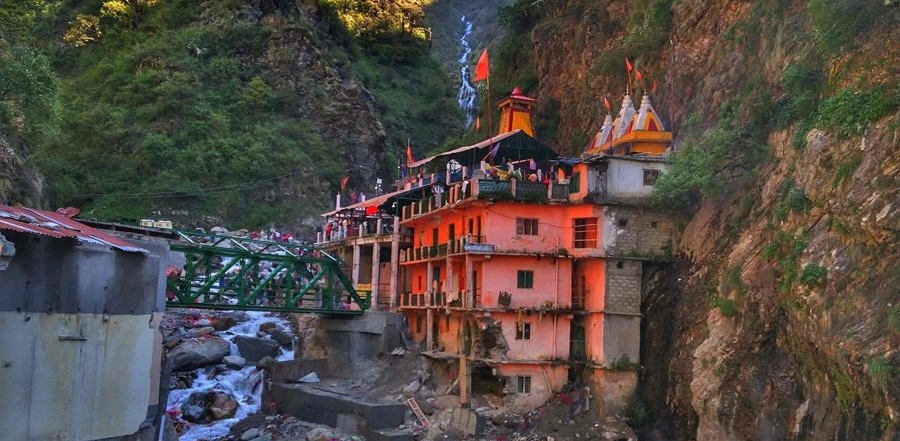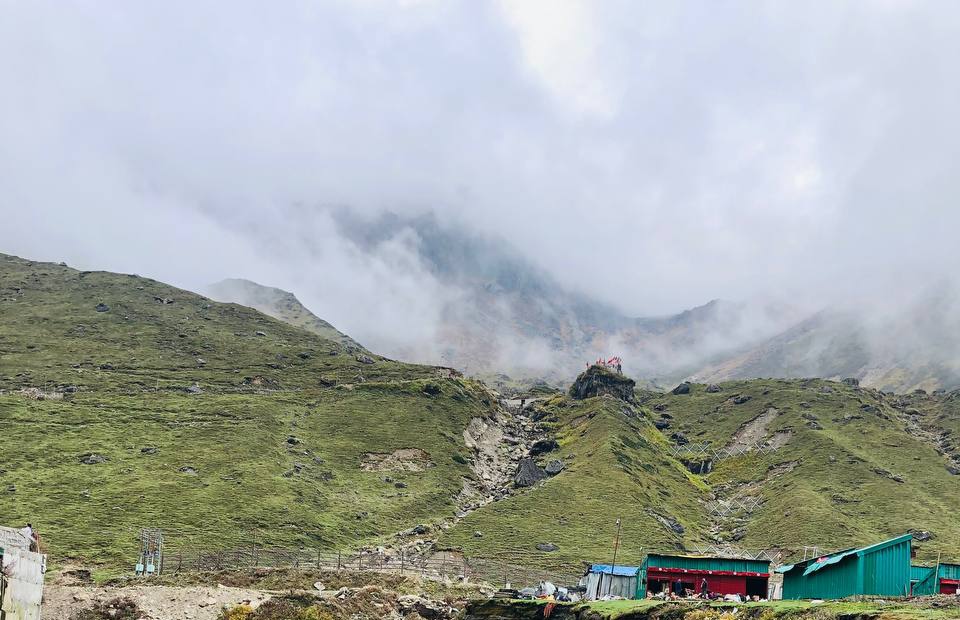
Overview of Yamunotri
Yamunotri is one of the Char Dham, the four most revered Hindu pilgrimage sites in the Himalayas, along with Gangotri, Kedarnath, and Badrinath. The Yamunotri Temple, located in the little mountain village, draws thousands of pilgrims each year and serves as the starting point of the Char Dham Yatra pilgrimage, which travels from Yamunotri to Gangotri and then on to Kedarnath and Badrinath (May to October). The Yamunotri Temple, which honours the Yamuna, the second-most holy river after the Ganges, is located in a small canyon not far from the Yamuna’s source. A plunge in the Yamuna River is supposed to guard against an early demise. To get to the temple (about 3,293 meter/m above sea level), devotees can either walk or ride a palanquin or a pony.
Yamunotri, also Jamnotri, is the source of the Yamuna River and the seat of the Goddess Yamuna in Hinduism. Since it is inaccessible, the true source, a frozen lake of ice and glacier (Champasar Glacier) on the Kalind Mountain at a height of 4,421 m above sea level, approximately 1 kilometre (Km) further up, is not frequently visited; the shrine was built at the base of the hill instead. Since the approach is so challenging, worshippers perform puja at the temple itself.
The revered goddess Yamuna is known for being Yama’s twin sister and the daughter of Sun; in the Vedas, she is referred to as Yami (lady of life). It is thought that taking a bath in the Yamuna’s holy waters will atone for all of your sins and guard you against an early or painful death.
Architecture of Yamunotri Temple
The sacred site of Goddess Yamuna is located on a side of Banderpoonch Parbat and not far from the base of Kalind Parbat (mountain). Yamunotri temple, which is tucked away in the daunting Himalayas, is said to have been built in 1839 by Naresh Sudarshan Shah, monarch of Tehri. The magnificent surroundings of the temple, one of the Chota Char Dham pilgrimage destinations, are enough to wow believers. The Yamuna River shoots down from one side of the temple, which is home to a statue of the Goddess Yamuna made of black marble. In a white stone near the Yamuna, Ganga Devi also finds her place.
Black marble serves as the foundation for the goddess Yamuna. The temple is devoted to the Yamuna River, which is symbolised by a silver deity that is covered in flowers. Hot springs gush forth from the mountain crevices not far from the temple. The most significant Kund is Suryakund. Before puja is done to the god, Divya Shila, a shrine located next to the Suryakund, is worshipped. In these hot springs of water, bound in muslin fabric, devotees cook rice and potatoes to give at the temple. Such prepared rice is brought home as prasadam.
History of Yamunotri Dham
According to an old narrative, here is where the wise man Asit Muni lived alone. He took regular baths in the Ganges and the Yamuna throughout his whole life. In his old age, he was unable to travel to Gangotri, but a Ganges stream materialised for him opposite Yamunotri. The Champasar Glacier (4,421 m), situated below the Banderpoonch Mountain, is the birthplace of the Yamuna, the daughter of the Sun deity Surya. Kalind Parvat, a mountain near the river’s source named after her father, is dedicated to him. Kalind is another name for Surya. Yamuna is known for her frivolity, which she inherited from her mother, who, according to legend, was unable to face her bright husband’s gaze.
Geography of Yamunotri Dham

Yamunotri, which is 3,293 m above sea level and is situated on the slope of Bandarpoonch Parvati in the Uttarkashi region of Uttarakhand’s Garhwal Himalayas. The temple and the holy hot springs in Janki Chatti, or 7 Km away, are Yamunotri’s main draws. The holy Yamuna descends through Saptarishi Kund before gushing southward to a string of cascades. The Yamuna and Ganges are separated by Kalind Parbat, which lies west of Bandarpoonch, the most prominent peak in Garhwal. The Hindu folklore says that the peak Banderpooch refers to Lord Hanuman’s tail and Bander, or monkey, alluding to Lord Hanuman. Hanuman Chatti is 13 Km away from the Yamunotri temple. To go to the Yamunotri shrine, you can rent ponies, horses, or palanquins. The motorable road extends 50 Km from Barkot to Jankichatti through Syanachatti, Ranachatti, and Hanumanchatti. Ponies, dandies, and kandies (baskets for transporting children) are also available for the 5-Km trip from Jankichatti to Yamunotri.
Weather in Yamunotri
Yamunotri’s typical maximum temperature ranges from 15 to 20 degrees Celsius, while its typical minimum temperature easily dips below the zero-degree threshold. In Yamunotri, wearing warm, woollen clothing is nearly always necessary.
Summer (May to June)
The summers in Yamunotri are cool and winters are very cold, with rains in the months of May and June. The gates of Yamunotri temple open during the start of summers. The weather is pleasant with observed maximum temperature around 20 degree Celcius and can get very cold at night. This is the best season for pilgrimage and sightseeing trips.
Monsoon (July to mid-September)
Due to several landslides, it is challenging to get to the temple during the monsoon season, which begins in the Yamunotri region in July to mid-September. It is advised that pilgrims stay away from the roads during monsoon season. Visitors may have trouble getting to the temple during the monsoon season due to the area’s excessive rains.
Winter (October to April)
From October to April, there is a wintery season marked by bitterly low temperatures and copious amounts of snowfall. Winters are a great time to enjoy snowfall, especially from the end of November until the middle of March. During this time, Yamunotri Temple is closed. For numerous hiking trips around Yamunotri, only experienced mountaineers and hikers travel there.
Best Time to Visit Yamunotri Temple
The ideal months to travel to Yamunotri are April to June and September to November. From the last week of April until the second week of November, the temple is open.
How to reach
By Air:
Jolly Grant airport, Rishikesh Road, Dehradun, is the nearest airport to Gangotri. Hire a cab or get a bus from here.
By Train:
There is just up-to-Rishikesh rail link. After that, you must utilise one of the buses or private taxis that run along the route. Additionally, shared jeeps or other comparable vehicles from Haridwar or Rishikesh are available. Do get an SUV or MUV like the Scorpio, Innova, Tavera, or Qualis. Haridwar, Dehradun, Kotdwar, and Kathgodam are the closest train stations.
By Bus:
Motorable roads come to an end at Janki Chatti, and it is from here that a difficult 6/5 Km trek begins to the revered Yamuna Devi shrine. To avoid the difficulties of the travel, one can use ponies or palanquins. From popular locations like Rishikesh, Dehradun, Uttarkashi, Tehri, and Barkot, buses and taxis are accessible.
Yamunotri Temple opening and closing date
The holy holiday of “Akshaya-Tritya,” which normally falls around the last or first week of April, marks the opening of the temple. On May 3, 2022, the Yamunotri Temple’s doors reopened. After a brief ritual on the holy day of Bhai Dooj, the closing day always follows.
Tentative opening date – First week of May
Tentative closing date – Last week of October
Some other keypoints about Yamunotri
Sightseeing near Yamunotri
Raithal village, Barsu village, Jankichatti, Hanumanchatti, Kharsal, Divya shila, Surya kund.
What is the length of the Yamunotri Glacier?
The Yamunotri Glacier, which is located close to the Bandarpunch peaks at a height of 6,387 metres (20,955 feet), is the location of the Yamuna River’s source. Due to snowfall, the Yamunotri temple is closed for six months during the winter.
Where is Yamuna born?
The Yamuna rises on the slopes of the Bandarpunch massif in the Great Himalayas near Yamnotri (Jamnotri) in western Uttarakhand.
Why is the water in Yamunotri hot?
After the rice is cooked, the devotee takes it and brings it to their home as prasadam. They also present the rice to the god and distribute it. This water originates from the hot springs that spew forth from the crevices in the hills close to the Yamunotri shrine. A mountain’s snow-capped top is surrounded by hot springs.
Which is more challenging: Yamunotri or Kedarnath?
Road access is available to Gangotri and Badrinath, but getting to Kedarnath and Yamunotri requires a 14-km and 5-km hike, respectively.
Who constructed Yamunotri Temple?
Naresh Sudarshan Shah, monarch of Tehri constructed the Yamunotri Temple in the 19th century.
Thank you for visiting our website (Your Fact Houses)
